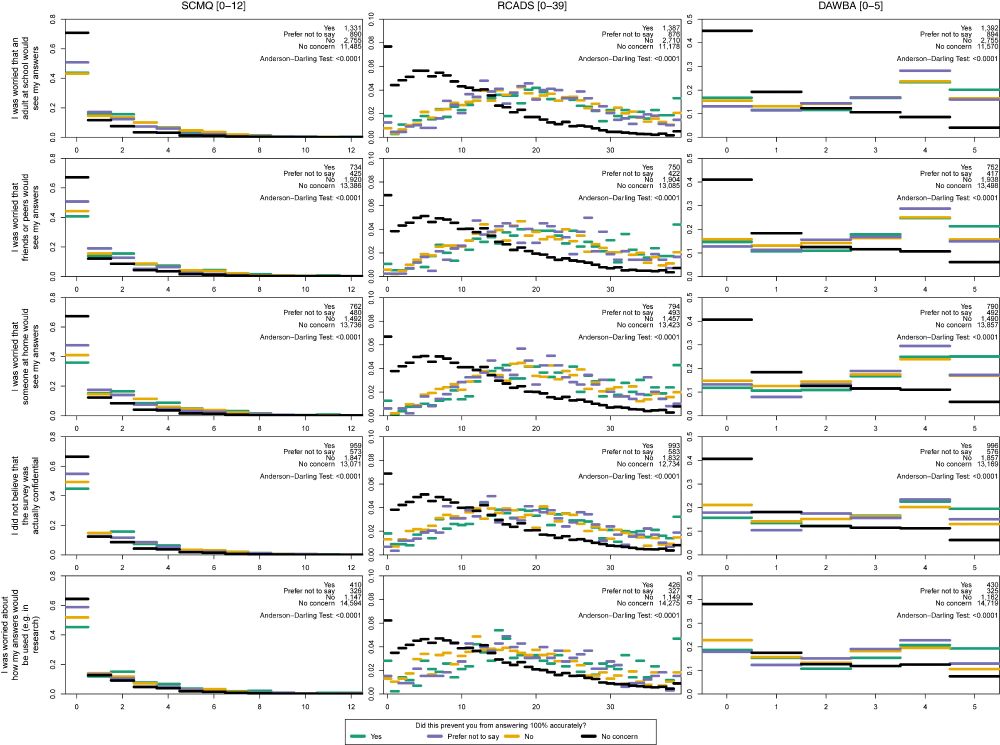
(she/her)

🗝️ Substantial VARIATIONS in SCORE distributions on measures of mental illness & adversity according to presence/absence of concerns.

🗝️ Substantial VARIATIONS in SCORE distributions on measures of mental illness & adversity according to presence/absence of concerns.
🗝️ 29.2% (2,379/8,160) of those with concerns reported that their concern(s) prevented them from answering '100% accurately'.

🗝️ 29.2% (2,379/8,160) of those with concerns reported that their concern(s) prevented them from answering '100% accurately'.


🗝️ GROUPS OF CONCERN
5 | #Gender diverse & gender non-disclosing adolescents accessed many types of support but found them generally less helpful than did their peers.
6 | Adolescents who didn't find their parent/carer helpful found very little else helpful either.
![[Figure 4 from paper] Shows 4 network diagrams that show patterns of access and perceived helpfulness by gender (all, girl, boy, gender diverse/gender non-disclosing).](https://cdn.bsky.app/img/feed_thumbnail/plain/did:plc:xpv6ssc77pgiuovb4ra2wrwx/bafkreigahxtkewiq2loetzsgwnjfciaznopfb7pimlcdc45v473vy3ydx4@jpeg)
![[Figure 6 from paper] 6 network diagrams comparing 3 focal support types (parents/carers, school MH teams, and CAMHS), with lefthand networks representing those who found the focal type helpful and righthand showing those who did not find it helpful.](https://cdn.bsky.app/img/feed_thumbnail/plain/did:plc:xpv6ssc77pgiuovb4ra2wrwx/bafkreibvkak5qgfhwivjf3jh6bkhhctvnv5mktmmdg7x4nw2lb5ee77qhe@jpeg)
🗝️ GROUPS OF CONCERN
5 | #Gender diverse & gender non-disclosing adolescents accessed many types of support but found them generally less helpful than did their peers.
6 | Adolescents who didn't find their parent/carer helpful found very little else helpful either.
🗝️ HELPFULNESS
3 | Friends & family were perceived as *most* helpful (incl. for adolescents w/ #mentalhealth difficulties).
4 | #CAMHS and helpline/online support were perceived as *least* helpful (ESP. for adolescents with #mentalhealth difficulties).
![[Figure 3 from the publication]: shows 2 network diagrams showing patterns of access and perceived helpfulness for those with sub-clinical and clinical RCADS scores (a measure of depression and anxiety)](https://cdn.bsky.app/img/feed_thumbnail/plain/did:plc:xpv6ssc77pgiuovb4ra2wrwx/bafkreianximcizrnqbahluoqdcy5br6worgj3ot32dnbtfeymxjr3jakze@jpeg)
🗝️ HELPFULNESS
3 | Friends & family were perceived as *most* helpful (incl. for adolescents w/ #mentalhealth difficulties).
4 | #CAMHS and helpline/online support were perceived as *least* helpful (ESP. for adolescents with #mentalhealth difficulties).
🗝️ PATTERNS OF ACCESS
1 | Many adolescents report having accessed #mentalhealth support in the last year (27% of our @oxwell.bsky.social sample) & around half of these have accessed 2+ types.
2 | Friends & family were most common, followed by schools & then health & social care.
![[Figure 2 from the publication]: shows a network diagram of 18 different types of mental health support young people report accessing in the last year, alongside perceived helpfulness.](https://cdn.bsky.app/img/feed_thumbnail/plain/did:plc:xpv6ssc77pgiuovb4ra2wrwx/bafkreifx3av5l7mtq3atk5ylekrcdzmll6v6btm2nlsbuvn25mu54h2hb4@jpeg)
🗝️ PATTERNS OF ACCESS
1 | Many adolescents report having accessed #mentalhealth support in the last year (27% of our @oxwell.bsky.social sample) & around half of these have accessed 2+ types.
2 | Friends & family were most common, followed by schools & then health & social care.
In our new paper, we combine a #network approach + applied research lens to explore where #youngpeople are accessing #mentalhealth support & how helpful they find it.
w/ Simon R White & @minafazeloxford.bsky.social
www.cambridge.org/core/journal...
![[Figure 2 from the publication]: shows a network diagram of 18 different types of mental health support young people report accessing in the last year, alongside perceived helpfulness.](https://cdn.bsky.app/img/feed_thumbnail/plain/did:plc:xpv6ssc77pgiuovb4ra2wrwx/bafkreifx3av5l7mtq3atk5ylekrcdzmll6v6btm2nlsbuvn25mu54h2hb4@jpeg)
In our new paper, we combine a #network approach + applied research lens to explore where #youngpeople are accessing #mentalhealth support & how helpful they find it.
w/ Simon R White & @minafazeloxford.bsky.social
www.cambridge.org/core/journal...




We used data from the OxWell Student Survey to explore #mentalhealth help-seeking among young people w/ experience of #adversity. 🗝️ messages below...
(with M Fazel, SR White, E Howarth, T Ford & PB Jones)
www.cambridge.org/core/journal...

We used data from the OxWell Student Survey to explore #mentalhealth help-seeking among young people w/ experience of #adversity. 🗝️ messages below...
(with M Fazel, SR White, E Howarth, T Ford & PB Jones)
www.cambridge.org/core/journal...
Tackling the #SDoH is essential for improving #mentalhealth & social justice must be central to this approach.
Read free here ➡️ onlinelibrary.wiley.com/doi/10.1002/...

Tackling the #SDoH is essential for improving #mentalhealth & social justice must be central to this approach.
Read free here ➡️ onlinelibrary.wiley.com/doi/10.1002/...
Really appreciated this opportunity to (try to!!) summarise the vast amount of research happening in child & adolescent public mental health & share some of our ideas on how to move the field forward.

Really appreciated this opportunity to (try to!!) summarise the vast amount of research happening in child & adolescent public mental health & share some of our ideas on how to move the field forward.

